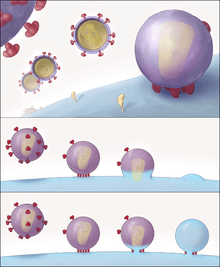Entry inhibitor
Entry inhibitors, also known as fusion inhibitors, are a class of antiretroviral drugs, used in combination therapy for the treatment of HIV infection. This class of drugs interferes with the binding, fusion and entry of an HIV virion to a human cell. By blocking this step in HIV's replication cycle, such agents slow the progression from HIV infection to AIDS.[1]

An HIV virion binds to a CD4+ human cell. The two bottom pictures depict two proposed models of HIV fusion with the cell.
HIV entry
Proteins
There are several key proteins involved in the HIV entry process.
- CD4, a protein receptor found on the surface of helper T cells in the human immune system, also called CD4+ T cells
- gp120, a protein on HIV surface that binds to the CD4 receptor
- CCR5, a second receptor found on the surface of CD4+ cells and macrophages, called a chemokine co-receptor
- CXCR4, another chemokine co-receptor found on CD4+ cells
- gp41, a HIV protein, closely associated with gp120, that penetrates the cell membrane
Binding, fusion, entry sequence
HIV entry into a human cell requires the following steps in sequence.
- The binding of HIV surface protein gp120 to the CD4 receptor
- A conformational change in gp120, which both increases its affinity for a co-receptor and exposes gp41
- The binding of gp120 to a co-receptor either CCR5 or CXCR4
- The penetration of the cell membrane by gp41, which approximates the membrane of HIV and the T cell and promotes their fusion
- The entry of the viral core into the cell
Entry inhibitors work by interfering with one aspect of this process.
Approved agents
- Maraviroc (Selzentry in USA, Celsentri in other countries) binds to CCR5, preventing an interaction with gp120. It is also referred to as a "chemokine receptor antagonist" or a "CCR5 inhibitor."[2]
- Enfuvirtide (Fuzeon) binds to gp41 and interferes with its ability to approximate the two membranes. It is also referred to as a "fusion inhibitor."
Investigation / experimental agents
Other agents are under investigation for their ability to interact with the proteins involved in HIV entry and the possibility that they may serve as entry inhibitors.[3]
- TNX-355, a monoclonal antibody that binds CD4 and inhibits the binding of gp120
- PRO 140, a monoclonal antibody that binds CCR5
- Fostemsavir (BMS-663068), an attachment inhibitor that interferes with the interaction of CD4 and gp120 by binding with it.
- Plerixafor was being developed to interfere with interaction between HIV and CXCR4, but showed little useful antiviral activity in recent trials.
- Epigallocatechin gallate, a substance found in green tea, appears to interact with gp120 as do several other theaflavins.[4]
- Vicriviroc, similar to maraviroc, is currently undergoing clinical trials for FDA approval.
- Aplaviroc, an agent similar to maraviroc and vicriroc. Clinical trials were halted in 2005 over concerns about the drug's safety.
- b12 is an antibody against HIV found in some long-term nonprogressors. It has been found to bind to gp120 at the exact region, or epitope, where gp120 binds to CD4. b12 seems to serve as a natural entry inhibitor in some individuals. It is hoped that further study of b12 may lead to an effective HIV vaccine.
- Griffithsin, a substance derived from algae, appears to have entry inhibitor properties.[5]
- DCM205, is a small molecule based on L-chicoric acid, an integrase inhibitor. DCM205 has been reported to inactivate HIV-1 particles directly in vitro and is thought to act primarily as an entry inhibitor.[6]
- CD4 specific Designed Ankyrin Repeat Proteins (DARPins) potently block viral entry of diverse strains and are being developed and studied as potential microbicide candidates [7]
- A polyclonal caprine antibody is in phase II human clinical trials that targets, among others sites, the GP41 transmembrane glycoprotein. The trials are being conducted by Virionyx, a New Zealand Company.[8]
- VIR-576 is a synthesized peptide which binds to gp41, preventing fusion of the virus with a cell membrane.
References
- ↑ Biswas P, Tambussi G, Lazzarin A (2007). "Access denied? The status of co-receptor inhibition to counter HIV entry" (abstract page). Expert Opin Pharmacother. 8 (7): 923–33. doi:10.1517/14656566.8.7.923. PMID 17472538.
- ↑ Pugach P, Ketas TJ, Michael E, Moore JP (August 2008). "Neutralizing antibody and anti-retroviral drug sensitivities of HIV-1 isolates resistant to small molecule CCR5 inhibitors". Virology. 377 (2): 401–7. doi:10.1016/j.virol.2008.04.032. PMC 2528836
 . PMID 18519143.
. PMID 18519143. - ↑ Merck Manual.com Human Immunodeficiency Virus (HIV) Infection Table 4
- ↑ Williamson, M.; McCormick, T.; Nance, C.; Shearer, W. (2006). "Epigallocatechin gallate, the main polyphenol in green tea, binds to the T-cell receptor, CD4: Potential for HIV-1 therapy". Journal of Allergy and Clinical Immunology. 118 (6): 1369–1374. doi:10.1016/j.jaci.2006.08.016. PMID 17157668.
- ↑ Emau P, Tian B, O'keefe BR, et al. (2007). "Griffithsin, a potent HIV entry inhibitor, is an excellent candidate for anti-HIV microbicide". J. Med. Primatol. 36 (4–5): 244–53. doi:10.1111/j.1600-0684.2007.00242.x. PMID 17669213.
- ↑ Duong YT, Meadows DC, Srivastava IK, Gervay-Hague J, North TW (May 2007). "Direct inactivation of human immunodeficiency virus type 1 by a novel small-molecule entry inhibitor, DCM205". Antimicrob. Agents Chemother. 51 (5): 1780–6. doi:10.1128/AAC.01001-06. PMC 1855571
 . PMID 17307982.
. PMID 17307982. - ↑ Schweizer, A; Rusert, P; Berlinger, L; Ruprecht, CR; Mann, A; Corthésy, S; Turville, SG; Aravantinou, M; Fischer, M; Robbiani, M; Amstutz, P; Trkola, A (Jul 25, 2008). "CD4-specific designed ankyrin repeat proteins are novel potent HIV entry inhibitors with unique characteristics.". PLoS Pathogens. 4 (7): e1000109. doi:10.1371/journal.ppat.1000109. PMC 2453315
 . PMID 18654624.
. PMID 18654624. - ↑ "virionyx.com". Retrieved 2007-08-26.
External links
- Fusion Inhibitor Resource Center
- HIV Fusion Inhibitors at the US National Library of Medicine Medical Subject Headings (MeSH)
This article is issued from Wikipedia - version of the 5/26/2016. The text is available under the Creative Commons Attribution/Share Alike but additional terms may apply for the media files.